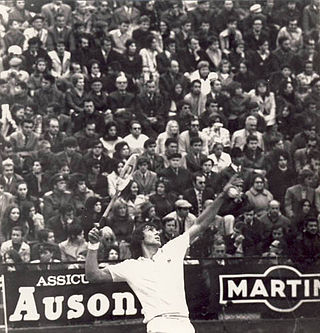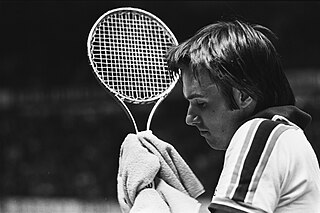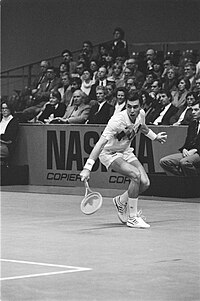The ILTF Grand Prix tennis circuit was a professional tennis tour for male players that existed from 1970 to 1989. The Grand Prix and World Championship Tennis (WCT) were the two predecessors to the current tour for male players, the ATP Tour, with the Grand Prix being more prominent.
World Championship Tennis (WCT) was a tour for professional male tennis players established in 1968 and lasted until the emergence of the ATP Tour in 1990. A number of tennis tournaments around the world were affiliated with WCT and players were ranked in a special WCT ranking according to their results in those tournaments.
The WCT Finals was a men's tennis tournament that served as the season-ending championship for the World Championship Tennis circuit. From 1971–1989 the event was held annually in Texas on indoor carpet courts. The 1971 quarterfinals and semifinals were played in Houston, and final played at Moody Coliseum in Dallas. The 1972–1979 editions were played at Moody Coliseum, and the 1980–1989 tournaments at Reunion Arena in Dallas. The 1974 edition was the first tennis tournament to experiment with electronic line calling. The first edition of the WCT Finals was in November 1971, just a few days before the equivalent event of the rival Grand Prix circuit. But the second edition occurred just six months later to accommodate NBC's new tennis coverage; the tournament final between Ken Rosewall and Rod Laver is credited as "the match that made tennis in the United States" because its unprecedented domestic television audience of 23 million fueled a massive increase in the sport's popularity. The ensuing editions were also held in the spring. John McEnroe had the most overall success, winning a record five titles. Because of the popularity of the 1972 final, another edition, less important and with half the prize money, was held in November in Rome. The prize money offered to the winner, Arthur Ashe, was US$25,000 compared to the US$50,000 won by Ken Rosewall for the main edition in May. A decade later there were three editions of the WCT Finals; the most important one in Dallas, and the others in autumn in Naples, Italy, and in winter in Detroit. The tournament was sponsored by Buick between 1985 and 1986, a brand of General Motors, and was called the "Buick WCT Finals".

The 1972 World Championship Tennis circuit was one of the two rival professional male tennis circuits of 1972. It was organized by World Championship Tennis (WCT). The circuit included twenty-three regular events, and two circuit finals, one taking place in May, counting for the second half of the 1971 season, and the first part of the 1972 season, and a smaller one taking place in November, counting for the second half of the 1972 season, from July through November.
The 1981 World Championship Tennis Finals was a men's tennis tournament played on indoor carpet courts. It was the 11th edition of the WCT Finals and was part of the 1981 Volvo Grand Prix. The tournament was played at the Reunion Arena in Dallas, Texas in the United States and was held from April 27 through May 3, 1981. The winners of the eight WCT tournaments that were part of the 1981 Grand Prix circuit qualified for the tournament augmented by the next best performers in the WCT points standings. Guillermo Vilas qualified by winning the last tournament held just before the WCT Finals, the River Oaks Tournament in Houston, but was unavailable to play. Jimmy Connors withdrew before the tournament due to gastroenteritis and Yannick Noah could not participate due to a shoulder injury. They were replaced by Sandy Mayer and Sam Giammalva respectively. First-seeded John McEnroe won the title and $100,000 prize money.

The 1982 Volvo Grand Prix was a professional tennis circuit held that year. It incorporated the four grand slam tournaments, the Grand Prix tournaments. The circuit was administered by the Men's International Professional Tennis Council (MIPTC). On 30 April 1981 World Championship Tennis (WCT) announced its withdrawal from the Grand Prix circuit, which it had been incorporated into since 1978, and the re-establishment of its own tour calendar for the 1982 season. To counter the threat of player leaving the Grand Prix tour for the WCT the MIPTC introduced a mandatory commitment to play at least 10 Grand Prix Super Series tournaments.

The 1981 Volvo Grand Prix was the only men's professional tennis circuit held that year. It consisted of the four Grand Slam tournaments and the Grand Prix tournaments. The World Championship Tennis (WCT) Tour was incorporated into the Grand Prix circuit. The WCT tour consisted of eight regular tournaments, a season's final, three tournaments categorized as special events and a doubles championship. In total 89 tournaments were held divided over 29 countries. The circuit was administered by the Men's International Professional Tennis Council (MIPTC).

The 1973 World Championship Tennis circuit was one of the two rival professional male tennis circuits of 1973. It was organized by World Championship Tennis (WCT). In April 1972 WCT signed an agreement with the International Lawn Tennis Federation (ILTF) as a result of which the 1973 men's tennis season was divided in a WCT section, which ran from January until May, and a Grand Prix circuit which was held from May onward. The WCT circuit divided the players into two groups of 32 players, with each group playing 11 tournaments of the 22 tournaments. The four highest ranked players from each group qualified for the season finals in Dallas. The total available prize money was almost $1,250,000.

The 1972 Commercial Union Assurance Grand Prix was a professional tennis circuit held that year and organized by the International Lawn Tennis Federation (ILTF). It consisted of 33 Grand Prix tournaments in different categories including three of the four Grand Slam tournaments and was followed by a season-ending Masters tournament. The circuit ran from February through November.

The 1971 Pepsi Cola Grand Prix was a professional tennis circuit held that year. It incorporated three of the four Grand Slam tournaments, the Grand Prix tournaments. It was the second edition of the Grand Prix circuit and was run by the International Lawn Tennis Federation (ITLF). In addition to regular tournament prize money a bonus prize money pool of £60,000 ($150,000) was available to be divided among the 20 highest ranking players after the last tournament. To be eligible for a share of the bonus pool a player had to compete in a minimum of nine tournaments. The circuit culminated in a Masters event in Paris for the seven highest point scoring players. Stan Smith was the winner of the circuit with 187 ranking points and four tournament victories.
The Grand Prix Super Series of men's tennis tournaments was part of the Grand Prix and World Championship Tennis tours between 1970 and 1989. They were held annually throughout the year in Europe, North America, Africa and Asia. These tournaments were the most prestigious and highest level events of the Grand Prix Tour after the majors and year-end championships. They had six name changes from 1970 through to 1977: Group One, Group B, Group A, Group AA, 5 Star and 6 Star, before settling on a consistent naming format called "Super Series" from 1978 until 1989.

The 1974 World Championship Tennis (WCT) circuit was one of the two rival professional male tennis circuits of 1974, the other being the Grand Prix circuit. It was organized by World Championship Tennis (WCT). It was the fourth edition of the WCT circuit and a total of 84 players participated. All players took part in the opening U.S. Pro Indoor tournament in Philadelphia and afterwards were divided into three groups of 28 players, with each group playing eight further tournaments.

The 1983 World Championship Tennis circuit was one of the two rival professional male tennis circuits of 1983. It was organized by World Championship Tennis (WCT). The WCT circuit withdrew from the Grand Prix circuit in 1982 and established its own full calendar season consisting of 20 tournaments. For the 1983 season the WCT circuit was downsized to eight tournaments and ran from January to May.

The 1977 season of the World Championship Tennis (WCT) circuit was one of the two rival professional male tennis circuits of 1977. It was organized by World Championship Tennis (WCT) and consisted of a preliminary series of twelve tournaments leading up to a singles play-off in Dallas and doubles play-off in Kansas City in May. 23 players participated and the season final was played by the eight best performers. It was won by American Jimmy Connors who defeated compatriot Dick Stockton in four sets. The total prize money for the 1977 WCT circuit was $2,400,000.

The 1975 World Championship Tennis circuit was one of the two rival professional male tennis circuits of 1975. It was organized by World Championship Tennis (WCT). The 1975 circuit divided the players in three groups, Red, Blue and Green who played 24 tournaments in 12 countries. The first tournament, U.S. Professional Indoor Championships, was a combined event as was the season's final which was played in Dallas by the eight best performers and was won by American Arthur Ashe who defeated Björn Borg from Sweden in four sets.

The 1976 World Championship Tennis circuit was one of the two rival professional men's tennis circuits of 1976. It was organized by World Championship Tennis (WCT) and consisted of a schedule of 25 tournaments leading up to a singles WCT Finals play-off in Dallas and a doubles play-off in Kansas City in May. A total of 54 players participated, 30 players less than in the previous three years, and the group system used in the previous editions was replaced by a single pool. The U.S. Pro Indoor was the only tournament in which all players participated, all other tournaments had a 16 men draw. The season final was played by the eight best performers and was won by the Swede Björn Borg who defeated Guillermo Vilas from Argentina in four sets. The total prize money for the 1976 WCT circuit was $2,400,000, including a $320,000 Avis Challenge Cup round–robin special event played in Hawaii in January and May.

The 1984 World Championship Tennis circuit was one of the two rival professional male tennis circuits of 1984. It was organized by World Championship Tennis (WCT). The WCT circuit withdrew from the Grand Prix circuit in 1982 and established its own full calendar season consisting of 20 tournaments. For the 1983 season the WCT circuit was downsized to eight tournaments and ran from January to May. The circuit was again downsized for the 1984 season to five tournaments and the best twelve competitors played at the WCT Finals in Dallas. This was the final year of the WCT as a separate tennis circuit.

The 1971 World Championship Tennis circuit was one of the two rival professional male tennis circuits of 1971. It was organized by World Championship Tennis (WCT) and was the first edition of the circuit. Points were awarded to players based on their tournament results. The circuit included twenty regular events and a WCT circuit final taking place in Houston/Dallas in November for the eight players with the highest points total. Each tournament had a minimum prize money of $50,000.
The 1981 WCT Tournament of Champions was a men's tennis tournament played on outdoor clay courts at the West Side Tennis Club in Forest Hills, Queens, New York City in the United States and part of the 1981 Grand Prix circuit. It was the fifth edition of the tournament and was held from May 4 through May 10, 1981. The event was open to players who had won a tournament worth at least $25,000 during the previous 12 months. Tenth-seeded Eddie Dibbs won the singles title and the accompanying first prize of $100,000 plus $3,050 in bonus money.
The 1981 United Virginia Bank Classic, also known as the Richmond WCT, was a men's tennis tournament played on indoor carpet courts at the Richmond Coliseum in Richmond, Virginia, United States. The event was part WCT Tour which was incorporated into the 1981 Volvo Grand Prix circuit. It was the 16th edition of the tournament and was held from February 2 through February 8, 1981. Eighth-seeded Yannick Noah won the singles title and $35,000 first-prize money after his opponent in the final Ivan Lendl retired with a pulled leg muscle.










